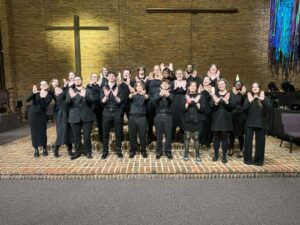Mario Dittrich and Reinhard Pester spoke on their “Stolpersteine Project,” or stumbling stones, from Lutherstadt Wittenberg Wednesday, April 3 in Shouvlin 105.
“One stone, one name, one person,” Catherine Waggoner, Communication professor, said. “How do you commemorate a painful past? How does a nation account for its ugly history? How do we mark a social injustice, so the memory is focused on the lives ended rather than on the spectacle of those doing the killing? Do we have gigantic monuments to peace of liberty or grand memorials to the fallen?— one stone, one name, one person.”
The idea behind the stumbling stones was created by Gunter Demnig, a German artist. They are concrete cubes bearing brass in honor of the victims of the Holocaust; they include: a name, when the person was born, when they died and how they died.
These stones are across 24 countries and are currently the world’s largest decentralized memorial; the memorial is made up of 70,000 stumbling stones.
“For Germans it’s a complete other issue than for U.S. Americans,” Dittrich said. “The German people—our ancestors—did the deeds, the United States—you freed Europe and we brought Europe horror. And if you felt responsible for that, you must think about doing something against it. There is a bridge behind German history…now Germany has completely changed…and that’s why we decided—Reinhard and me and our group— to be responsible for the stumbling stones in Wittenberg.”
Pester is the author of “(Un)Forgotten Neighbors,” a book on the 30 stumbling stones in Lutherstadt Wittenberg, Germany; he said a memorial is an emerging experience, a step back into history and with the stumbling stones they make people “stumble” or pause when seen.
“If you have a name, if you have a birthday, if you have a house number… things like that… you have a little biography…they were here,” Pester said.
Shayden Ramey, ’15, translated Pester’s book into English and read a section from it during the event.
Anna Eggert, a high school student from Germany, spoke on her school art project with the stumbling stones.
Eggert said in her class that they were assigned families, read and researched them, drew victims from the stones and if they didn’t have information on what the person looked like, they had to draw themselves.
She said they went around Lutherstadt Wittenberg and put their drawings next to the stones once they were complete and taught people about the history of the stones and victims on the street.
The talk also included a light meal of sandwiches, fruit salad, chips, cookies and drinks.







